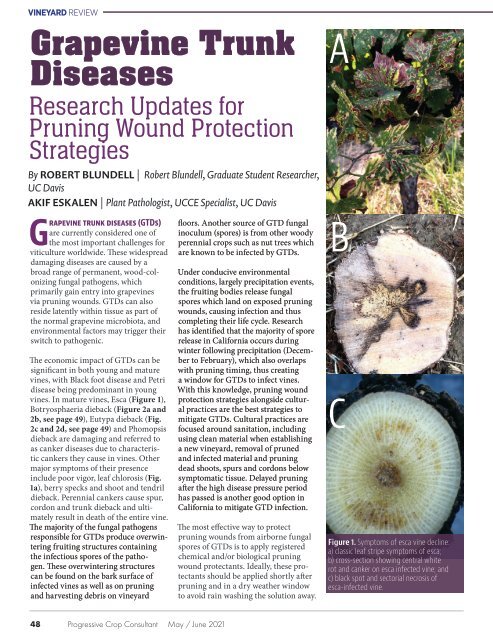Progressive Crop Consultant May/June 2021
You also want an ePaper? Increase the reach of your titles
YUMPU automatically turns print PDFs into web optimized ePapers that Google loves.
VINEYARD REVIEW<br />
Grapevine Trunk<br />
Diseases<br />
Research Updates for<br />
Pruning Wound Protection<br />
Strategies<br />
A<br />
By ROBERT BLUNDELL | Robert Blundell, Graduate Student Researcher,<br />
UC Davis<br />
AKIF ESKALEN | Plant Pathologist, UCCE Specialist, UC Davis<br />
Grapevine trunk diseases (GTDs)<br />
are currently considered one of<br />
the most important challenges for<br />
viticulture worldwide. These widespread<br />
damaging diseases are caused by a<br />
broad range of permanent, wood-colonizing<br />
fungal pathogens, which<br />
primarily gain entry into grapevines<br />
via pruning wounds. GTDs can also<br />
reside latently within tissue as part of<br />
the normal grapevine microbiota, and<br />
environmental factors may trigger their<br />
switch to pathogenic.<br />
The economic impact of GTDs can be<br />
significant in both young and mature<br />
vines, with Black foot disease and Petri<br />
disease being predominant in young<br />
vines. In mature vines, Esca (Figure 1),<br />
Botryosphaeria dieback (Figure 2a and<br />
2b, see page 49), Eutypa dieback (Fig.<br />
2c and 2d, see page 49) and Phomopsis<br />
dieback are damaging and referred to<br />
as canker diseases due to characteristic<br />
cankers they cause in vines. Other<br />
major symptoms of their presence<br />
include poor vigor, leaf chlorosis (Fig.<br />
1a), berry specks and shoot and tendril<br />
dieback. Perennial cankers cause spur,<br />
cordon and trunk dieback and ultimately<br />
result in death of the entire vine.<br />
The majority of the fungal pathogens<br />
responsible for GTDs produce overwintering<br />
fruiting structures containing<br />
the infectious spores of the pathogen.<br />
These overwintering structures<br />
can be found on the bark surface of<br />
infected vines as well as on pruning<br />
and harvesting debris on vineyard<br />
floors. Another source of GTD fungal<br />
inoculum (spores) is from other woody<br />
perennial crops such as nut trees which<br />
are known to be infected by GTDs.<br />
Under conducive environmental<br />
conditions, largely precipitation events,<br />
the fruiting bodies release fungal<br />
spores which land on exposed pruning<br />
wounds, causing infection and thus<br />
completing their life cycle. Research<br />
has identified that the majority of spore<br />
release in California occurs during<br />
winter following precipitation (December<br />
to February), which also overlaps<br />
with pruning timing, thus creating<br />
a window for GTDs to infect vines.<br />
With this knowledge, pruning wound<br />
protection strategies alongside cultural<br />
practices are the best strategies to<br />
mitigate GTDs. Cultural practices are<br />
focused around sanitation, including<br />
using clean material when establishing<br />
a new vineyard, removal of pruned<br />
and infected material and pruning<br />
dead shoots, spurs and cordons below<br />
symptomatic tissue. Delayed pruning<br />
after the high disease pressure period<br />
has passed is another good option in<br />
California to mitigate GTD infection.<br />
The most effective way to protect<br />
pruning wounds from airborne fungal<br />
spores of GTDs is to apply registered<br />
chemical and/or biological pruning<br />
wound protectants. Ideally, these protectants<br />
should be applied shortly after<br />
pruning and in a dry weather window<br />
to avoid rain washing the solution away.<br />
B<br />
C<br />
Figure 1. Symptoms of esca vine decline:<br />
a) classic leaf stripe symptoms of esca;<br />
b) cross-section showing central white<br />
rot and canker on esca infected vine; and<br />
c) black spot and sectorial necrosis of<br />
esca-infected vine.<br />
48 <strong>Progressive</strong> <strong>Crop</strong> <strong>Consultant</strong> <strong>May</strong> / <strong>June</strong> <strong>2021</strong>


















